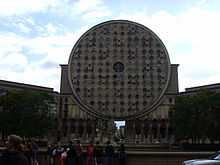Noisy-le-Grand
| Noisy-le-Grand | ||
|---|---|---|

|
|
|
| region | Île-de-France | |
| Department | Seine-Saint-Denis | |
| Arrondissement | Le Raincy | |
| Canton | Noisy-le-Grand | |
| Community association |
Métropole du Grand Paris and Grand Paris Grand Est |
|
| Coordinates | 48 ° 51 ' N , 2 ° 33' E | |
| height | 36-113 m | |
| surface | 12.95 km 2 | |
| Residents | 68,183 (January 1, 2017) | |
| Population density | 5,265 inhabitants / km 2 | |
| Post Code | 93160 | |
| INSEE code | 93051 | |
| Website | www.ville-noisylegrand.fr | |
 Noisy-le-Grand town hall |
||
Noisy-le-Grand is a French city with 68,183 inhabitants (as of January 1, 2017) in the eastern part of the greater Paris area . It is located on the Marne and belongs to the development area of the Ville nouvelle Marne-la-Vallée . Noisy-le-Grand belongs to the Île-de-France region , the Seine-Saint-Denis department , the Le Raincy arrondissement and the Noisy-le-Grand canton . The canton of Noisy-le-Grand consists of two municipalities: Noisy-le-Grand and Gournay-sur-Marne , which borders to the east. The inhabitants are called Noiséens . Noisy-le-Grand is the southernmost commune of the Seine-Saint-Denis department.
history
Noisy-le-Grand was already the residence of the Merovingian kings in the 5th century . In 1060 the city passed from royal possession to the monks of Saint-Martin-des-Champs. In the Middle Ages, wine was produced in Noisy-le-Grand, which was considered to be one of the best in Ile-de-France until the beginning of the 17th century, when the quality of the wine decreased. After the French Revolution in 1789, properties belonging to the Saint Martin monks were sold.
Noisy was a rural village until the beginning of the 20th century when the “Compagnie de Chemins de Fer Nogentais” tram was built to connect Noisy-le-Grand with the center of Paris. The banks of the Marne attracted Parisian visitors who fished here, went for a walk or visited the dance halls that became charming in the 1920s in the Quartier des Grammats and the Rive. The composer Claude Terrasse (1867–1923) and the actor Michel Simon (from 1934) settled here.
A famous citizen of the city was Joséphine de Beauharnais , later Empress and wife of Napoleon I, who lived on Docteur Sureau Street from the age of 16 . She married Alexandre de Beauharnais (guillotined 1794) in 1779 in the church of Saint-Sulpice in Noisy-le-Grand. The house in which she lived became a hospice for children with tuberculosis at the beginning of the 19th century. In 1920, mother Francoise Cabrini from the Sacre Coeur Order founded an orphanage there for young Italian girls.
Population development
| year | 1926 | 1962 | 1968 | 1975 | 1982 | 1990 | 1999 | 2006 | 2017 |
| Residents | 4,286 | 16,813 | 25,440 | 26,662 | 40,585 | 54.032 | 58,217 | 61,341 | 68.183 |
In the next few years, the population of Noisy-le-Grand will continue to rise sharply, as the municipality is part of the Porte de Paris (Marne-la-Vallée) development in the 1st sector of the Ville nouvelle Marne-la-Vallée .
traffic
Noisy-le-Grand has two RER stations: Les Yvris - Noisy-le-Grand on the Paris – Mulhouse line ( RER E ) and Noisy-le-Grand - Mont d'Est ( RER A ). Mont d'Est is also the central stop for the bus routes.
Attractions
A landmark of the city is the huge postmodern residential complex Arènes de Picasso by Manuel Núñez Yanowsky from 1985. Its two wheel-shaped skyscrapers are popularly known as "les camemberts". Equally known for its special architecture are the Espaces d'Abraxas by Ricardo Bofill , which have been the setting in numerous films and video clips.
The most famous citizen of the city was the actor Michel Simon , who had his residence here and after whom the Espace Michel Simon is named, who u. a. houses a municipal theater with an event hall with 724 seats, a bar, an exhibition area of 800 square meters and a media library that offers numerous activities for a young audience. The Espace, designed by the architect Georges Pappas, was inaugurated on February 25, 1989.
The current town hall is housed in a castle that was built between 1963 and 1865 by the Périac Buisson family. The city bought it in 1926 and inaugurated it on July 31, 1927. In the course of time there have been some structural changes such as B. the addition of a staircase, balcony and clock tower. Between 2009 and 2012, extensive renovation work was carried out according to plans by the architects Chaix & Morel und Partner, who designed a building ensemble of 11,000 square meters consisting of the historic town hall and a new building with two wings and three floors. The latter is considered to be particularly environmentally conscious.
The Saint Sulpice church at the cemetery was built in 1140–1484 and restored in 2011–2013.
See also: List of Monuments historiques in Noisy-le-Grand
Road renovation work in spring 2004 - Avenue Aristide Briand , in the background the town hall
literature
- Le Patrimoine des Communes de la Seine-Saint-Denis. Flohic Éditions, 2nd edition, Paris 2002, ISBN 2-84234-133-3 , pp. 239–245.
Web links
- Population data and information about the municipality
- History of Noisy: http://nlghistoire.fr/
Individual evidence
- ^ Clos Saint-Vincent Confrérie - Noisy Le Grand - Tourisme - Marne La Vallée. Retrieved September 30, 2019 .
- ↑ histoire-de-noisy-le-grand - mrc-noisy-le-grand. Retrieved June 26, 2019 .









